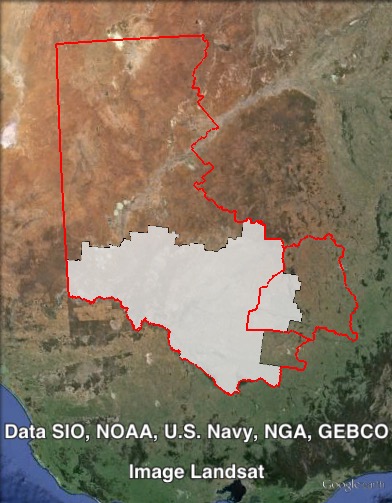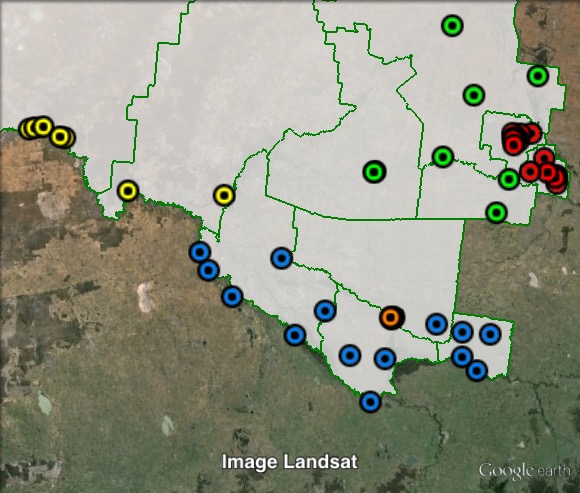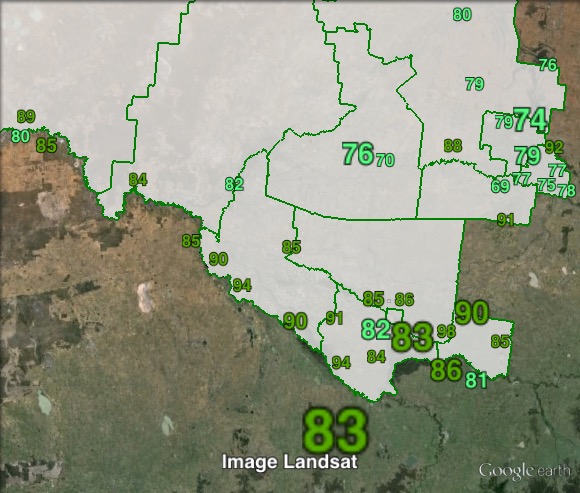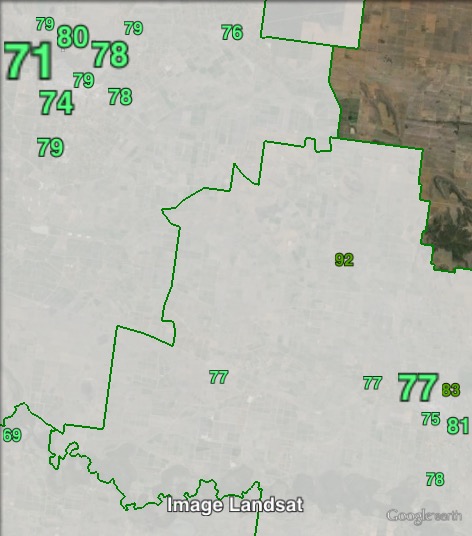NAT 30.9%
Incumbent MP
- Adrian Piccoli, Member for Murrumbidgee since 1999.
- John Williams, Member for Murray-Darling since 2007.
Geography
South-western NSW. The seat of Murray borders Victoria and South Australia, and includes the towns of Griffith, Leeton, Deniliquin and Wentworth. It covers the entirety of Balranald, Berrigan, Carrathool, Conargo, Deniliquin, Griffith, Hay, Leeton, Murray, Murrumbidgee, Wakool and Wentworth local government areas.

Redistribution
Murray is a newly-created seat, with just over 50% of the seat coming from the seat of Murray-Darling and the remainder coming from Murrumbidgee, both of which have effectively been broken up. Most of the seat’s geographic area was part of Murray-Darling, with the exception of Griffith, Leeton and Murrumbidgee local government areas and a small part of the Carrathool council area.
The former seat of Murray-Darling was renamed due to the transfer of Broken Hill into Barwon, after previously being included in Murray-Darling.
History
Murray existed as a seat in the NSW Legislative Assembly from 1859 to 1999, when it was renamed Murray-Darling after expanding to cover Broken Hill. In 2015 the seat will be restored to its new name after Broken Hill was transferred out of the seat. The seat has also taken in parts of the abolished seat of Murrumbidgee.
Murray had been dominated by the Country/National Party since 1932, when it had been won by Joe Lawson. He lost Country Party preselection 35 years later in 1967, and was re-elected as an independent in 1968. He held the seat as an independent until his death in 1973.
The following by-election was won by Lawson’s daughter Mary Meillon, who had run as a Liberal. She held the seat until her death in 1980.
The 1980 Murray by-election was won by National Country Party candidate Tim Fischer. He had held the safe Country Party seat of Sturt (a different seat with very different borders to the older Labor seat of the same name) since 1971. Sturt was set to be abolished at the 1981 election, and Fischer resigned his seat early to contest Murray.
Fischer resigned from Sturt in 1984 to contest the federal seat of Farrer. He won the seat and held it until his retirement in 2001. He became leader of the federal National Party in 1990, serving in that role until 1999. He was Deputy Prime Minister from 1996 to 1999.
Jim Small won Sturt at the 1984 by-election for the National Party. He held it until 1999.
When Murray and Broken Hill were merged, the new seat of Murray-Darling had a notional majority for the Nationals. Both sitting MPs retired, and the seat was won by the ALP’s Peter Black.
Black was re-elected in 2003, and developed a reputation as a controversial Labor MP. In 2007, a redistribution made the seat again a notional Nationals seat, and Black was defeated by Nationals candidate John Williams.
Murrumbidgee was one of only two districts to have existed continuously since the first Legislative Assembly was elected in 1856. The seat was a two-member district from 1856 to 1859, a single-member district from 1859 to 1880, a two-member district until 1885, a three-member district from 1885 to 1894, a single-member district from 1894 to 1920, a three-member district from 1920 to 1927, and a single-member district from 1927 until its abolition at the 2015 election.
The seat was dominated by the ALP in the middle part of the last century, but has been held by the National Party since 1984.
In 1941, the sitting Country Party MP, Robert Hankinson, retired. The official Labor candidate was defeated by independent Labor candidate George Enticknap, who was then welcomed into the Labor caucus in the Parliament. He served as a minister from 1960 to 1965, when he retired.
Al Grassby won Murrumbidgee for the Labor Party at the 1965 election. He resigned from the seat in 1969 to take the federal seat of Riverina. He served as Minister for Immigration from 1972 to 1974, when he lost Riverina.
Lin Gordon won the 1970 Murrumbidgee by-election for the ALP. He served as a minister from 1976 until his retirement in 1984.
In 1984, Murrumbidgee was won by the National Party’s Adrian Cruickshank. He came third on primary votes, but preferences from the Liberal Party pushed him ahead of independent candidate Thomas Marriott. Marriott’s preferences elected Cruickshank over the Labor Party. He held the seat until his retirement in 1999.
Murrumbidgee has been held by the National Party’s Adrian Piccoli since 1999. He has served as deputy leader of the NSW National Party since 2008, and now serves as Minister for Education.
Candidates
Sitting Nationals MP for Murray-Darling John Williams is not running for re-election.
- Brian Mills (Independent)
- Max Buljubasic (Labor)
- Garry Codemo (No Land Tax)
- Jordanna Glassman (Greens)
- Adrian Piccoli (Nationals)
- Helen Dalton (Independent)
- David Elder (Christian Democratic Party)
- Atul Misra (Independent)
Assessment
Murray is a very safe Nationals seat, following the removal of Labor-leaning Broken Hill.
2011 election result – Murray-Darling
| Candidate | Party | Votes | % | Swing | Redist |
| John Williams | Nationals | 28,941 | 74.1 | +17.6 | 78.0 |
| Neville Gasmier | Labor | 8,096 | 20.7 | -16.3 | 17.4 |
| Heidi Hendry | Greens | 2,031 | 5.2 | +2.8 | 3.3 |
| Others | 1.4 |
2011 two-party-preferred result – Murray-Darling
| Candidate | Party | Votes | % | Swing | Redist |
| John Williams | Nationals | 29,466 | 77.2 | +17.1 | 80.9 |
| Neville Gasmier | Labor | 8,684 | 22.8 | -17.1 | 19.1 |
2011 election result – Murrumbidgee
| Candidate | Party | Votes | % | Swing |
| Adrian Piccoli | Nationals | 31,414 | 73.4 | +10.2 |
| William Wood | Labor | 8,431 | 19.7 | -12.2 |
| George Benedyka | Greens | 1,577 | 3.7 | -1.2 |
| Fiona Bushby | Christian Democrats | 1,362 | 3.2 | +3.2 |
2011 two-party-preferred result – Murrumbidgee
| Candidate | Party | Votes | % | Swing |
| Adrian Piccoli | Nationals | 32,260 | 77.9 | +11.8 |
| William Wood | Labor | 9,149 | 22.1 | -11.8 |

Booth breakdown
Booths in Murray have been split into five parts. The most populous centre of the electorate is the two council areas of Griffith and Leeton, so these have been grouped together as “Griffith-Leeton”.
The south-eastern town of Deniliquin has also been grouped together, and the remaining booths have been split into north-east, north-west (including Wellington) and south.
The Nationals won a large majority of the two-party-preferred vote, ranging from 77.2% in Griffith-Leeton to 86.2% in the south.
| Voter group | NAT 2PP % | Total | % of votes |
| Griffith-Leeton | 77.2 | 15,460 | 33.0 |
| South | 86.2 | 9,615 | 20.5 |
| Deniliquin | 83.3 | 3,748 | 8.0 |
| North-East | 77.9 | 3,721 | 7.9 |
| North-West | 83.9 | 3,703 | 7.9 |
| Other votes | 81.2 | 10,593 | 22.6 |




My prediction: Easy National hold.
Seven of the eight candidates tend to dispute that prediction
The presence of alternative candidates doesn’t make a safe seat any less safe.